As you well know, tone production is influenced by nail length and shape (an issue for future discussion) as well as the amount of fingertip (nail excluded) that contacts the strings. With all things being equal, I'd like to take a look at the basic principle of where the hand is placed and how the fingers 'attack' the string. Once these are explored, we can look into those other aforementioned factors.
The electric guitarist who has never played an acoustic instrument often thinks to himself "Those acoustic guys have it so easy -- all they have to do is sit down and play. I've got to worry about my guitar's pickups, the amplifier and its settings, effects pedals..." Then the folks who have only played acoustics are muttering under their breath "Yeah, those electric clowns have it soooo easy. All they do is grab the guitar and plug it in, then all the electrical stuff gives them great tone." Neither are correct in their assessment as you very well know.
It is always said that ideally the right hand should be positioned so that the fingers are plucking the strings even with the rosette immediately to the bridge side of the sound hole. See the picture to the right. Notice that my fat hand is pretty much in this 'ideal' starting position. This is not the place where the hand MUST stay at all times. It is a good all-around point at which we can begin to make tone. Also notice that Fu Manchu thumb nail. That's too long folks, I filed it after I saw this picture!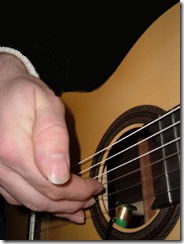
With the hand in this position you can get a decent enough variety of sound by altering the nails' angle of attack as well as the usual volume changes. Yes, you can pluck soft and loud and everywhere in between. There is so much more available though. Pity if we don't explore all the possibilities.
On a spruce-topped guitar such as the one in the picture (a 2004 Kenny Hill Munich) the tone is round and full when compared to a cedar-topped guitar. The cedar has what I would consider more extremes -- more treble and more bass. The spruce has more warmth and is sort of biased towards the mids. The Hill does have an awesome bass, but I believe that is a credit to Mr. Hill's construction technique as well as his adherence to the design of Hermann Hauser. What does this mean to me when I play the Hill as compared to when I play a Ramirez? Just this: The Hill is going to require me to do something to heighten the treble output -- when required. The Ramirez is going to require me to back off a bit and concentrate on bringing up the mids -- when required. Of course, that is with all things being equal. Contemporary performance practice will tell you that Bach sounds best on spruce and Albeniz sounds best on cedar. I think both can be performed with artistic merit on either instrument. What is needed is a good knowledge of how to get what you want out of a particular top wood, be it spruce, cedar or redwood. (Or knotty pine in my tax bracket...)
Let's look at some absolutes. Your sitting behind your guitar which just happens to be built of that new sprucedar wood that has the most even tone production of any guitar ever conceived by the mind of man. So all one needs to do is produce the tone he or she wants with no consideration of the instrument's inherent characteristics.
Your hand is in that perfect position we see in the first photo up above. You're playing a piece and suddenly in the music you see the marking ponticello. 'Pluck it by the bridge' So your hand moves back to the position we see in this photo. By the way, on a Ramirez, this sounds like a Strat on the bridge pickup -- like a screaming banshee -- a bit much except in very specific circumstances. On the Hill, this position has a nice trebly ring, not 'over-the-top' at all. Please notice the position of my hand for future reference. There is something going on with the nails that we'll touch upon in a little while.
The piece you are playing now requires a darker, more somber sound to heighten the dramatic and emotional intent you feel the composer intended. It's time to slide up from way back there at the bridge, but you don't necessarily want to attain that 'perfect' position we looked at first. Plucking the strings up by the end of the neck -- and try not to totally block the soundhole unless you have one of the new guitars with ports in the upper bouts -- and dip into your instrument's extreme bass range. Look at this next photo. Chubby's food-hook is blocking the soundhole, but I can live with it because I can dig in and pull more sound out of that little Hill than you would imagine unless you've played one.
Okay, we've got the extremes covered -- you are playing tone ranging from a screaming stainless steel angel with a chromium heart to the smokey sound of a humid summer dawn. How evocative I am! But your tone can be even more evocative. It's not just where we place our fingers, it is how we attack the string as well. Coupling attack with position will yield about ten million different tones more or less.
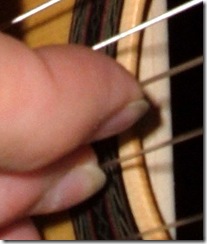 More obscenity from the master of finger porn! Seen here is my first finger -- the fingertip is touching the string and the nail is about to strike it absolutely perpendicularly. The nail is not angled in any direction, it is straight-on. This will impart all the pluck's energy to the string more or less at once. Like pulling and releasing a bowstring, it'll all be over in a nanosecond. I liken the tone to that of the entire frequency response available at that position along the string being used all at once. You've just written a check for the balance of your account. Still, some variety can be achieved even with this attack. If more fingertip plucks the string and less nail, the tone will be a bit warmer. As an aside, fingernails should never be so long that you can't get the fat of the finger onto the string without tearing the label in your guitar. If you can pick your nose and extract brain cells, invest in a file. Long nails sound ticky tacky and break really easily. They are a true liability, despite the ability to mimic a harpsichord with 'em. Moderation in everything, please! (Even moderation, but that is a tale for another day.)
More obscenity from the master of finger porn! Seen here is my first finger -- the fingertip is touching the string and the nail is about to strike it absolutely perpendicularly. The nail is not angled in any direction, it is straight-on. This will impart all the pluck's energy to the string more or less at once. Like pulling and releasing a bowstring, it'll all be over in a nanosecond. I liken the tone to that of the entire frequency response available at that position along the string being used all at once. You've just written a check for the balance of your account. Still, some variety can be achieved even with this attack. If more fingertip plucks the string and less nail, the tone will be a bit warmer. As an aside, fingernails should never be so long that you can't get the fat of the finger onto the string without tearing the label in your guitar. If you can pick your nose and extract brain cells, invest in a file. Long nails sound ticky tacky and break really easily. They are a true liability, despite the ability to mimic a harpsichord with 'em. Moderation in everything, please! (Even moderation, but that is a tale for another day.)
Now we see some more finger pornography, Sorry about the scandalous images, but we are all grownups and must get past that natural revulsion... Note that the fingernail is all that is coming into contact with the string. The nail is also slightly angled so that it will not simply pluck the string, no, it will almost bow it. The string will travel along the nail until finally being released. The resulting tone is less bite and has more apparent duration of attack. It is less BOING! and more Whaaaaaa... It is less trebly. Using this technique on a Ramirez down by the bridge will eliminate the scream and give you more of the ping you want when playing ponticello. Also, by using these two plucks, one needn't move one's hand to shade a note or passage. Cutting down on unnecessary motion is a good thing. It is a wonderful thing in a recital!
Variety of tone. It is a noble goal that is readily accomplished with a little thought and a critical ear -- that and a good command of right hand technique.







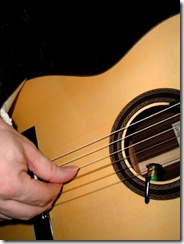
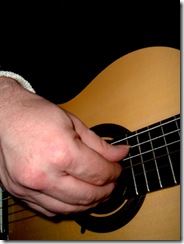
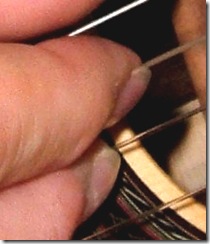



No comments:
Post a Comment